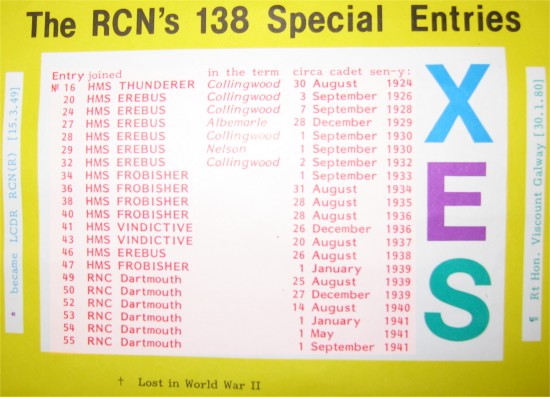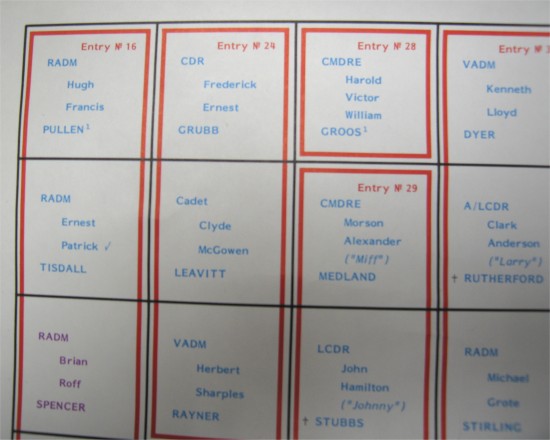Royal Canadian Navy Special Entries
Officer training during the interwar years

Background
Royal Navy : Admiralty Circular No. 393 of 23 October 1859, [footnote: published Navy List, 20 March 1860), p. 241], effective 1 April 1860, defined cadet training as being for boys entering aged twelve to fourteen to obtain twelve months' instruction in a harbour training ship; then three further months of sea-going training ship for the purposes of practical instruction; then, subject to satisfactory conduct, appointment to the Fleet with the rate of Midshipman. The Eurydice was commissioned for this purpose.
HMS Britannia replaced HMS Illustrious in 1858 as a training ship specifically for naval cadets, and with HMS Excellent brought young midshipmen into a navy that was technologically advancing fast, but remained rooted in traditions dating back to Nelson and Blake. After five years as midshipman, an examination board would promote them to the new rank of sublieutenant, or throw them out of the navy. Those that passed went on to the Royal Naval College at Greenwich (opened 1873.) With the change from wood to iron construction, the School of Naval Architecture and Marine Engineering also moved to Greenwich, and HMS Excellent developed curricula in mines, torpedoes and electrics. Admiral J.A "Jack" Fisher became Second Sea Lord in 1902, placing new emphasis on gunnery, submarines and torpedo boats; training establishments revised their courses. The year of 1905 saw not only the start of construction of Fisher's Dreadnaught, but also the opening of the brick and mortar HMS Britannia at Dartmouth, long after the old wooden two-decker had gone.

RCN, origins, ....
RCN, early officer training, up to 1922? 1924?, ....
With the National Defence Act of 1922, the Department of the Naval Service ceased to exist. Thus, the Hydrographic, Tidal, Fisheries Protection, and Wireless Branches were transferred back to the Department of Marine and Fisheries, while the Naval Branch joined the new Department of National Defence.
The Department of the Naval Service ceased to exist in 1922 (National Defence Act of 1922) becoming part of the new Department of National Defence. The nation was tired of war and the Navy entered a period of budget cuts. The Hydrographic, Tidal, Fisheries Protection, and Wireless Branches were transferred from the Naval Service back to the Department of Marine and Fisheries;
RCN, politics and decision 1921-22, to halt officer training in Canada and rely upon the Royal Navy
The reorganization of the Royal Canadian Navy began shortly after the First World War and was largely complete by early 1920. This post-war period of reorganization saw the demobilization of all officers and ratings not deemed essential, and by the end of 1922 this included the closing of the Royal Naval College of Canada and the discharge of the officers undergoing training. The end result was that Canada’s permanent naval force was composed of approximately 400 all ranks allocated to Naval Barracks, Halifax and Esquimalt, and the only two ships remaining, HMC Ships Patriot and Patrician.We hold (rcn-dsjones fonds) a document, or "poster", measuring 24 x 24 inches (61 x 61 cm), compiled by Geoffrey Phillips of Ottawa who consulted with John H. Beattie of Cobham, Surrey (U.K), and printed by Love Printing Service Ltd of Ottawa (moved to Stittsville in 1984, now unfindable; the owner Ian McJannet died March 2013.) It is undated; however it cannot predate Vadm R.S.G Stephens promotion to VAdm, seniority 15 June 1977. The archival quality of the paper and printing also suggest a date in the late 1970s. Geoffrey Phillips is elusive; we might assume, rather tentatively, that he is the Geoffrey Huntley Phillips, Special Entry #38, HMS Frobisher of 28 August 1935, engineering branch, promoted (RCN) Lieutenant Commander (E) to Commander (E) in the London Gazette of 19 January 1961. Retired 23 December 1963 (Crowsnest, January 1963.) John H. Beattie is the author of The Churchill Scheme: The Royal Naval Special Entry Cadet Scheme 1913-1955.
In 1922, as a result of a marked decline in the navy’s budget, the Chief of the Naval Staff recommended to the Government that reserve training centres should be established across Canada as an economical means of producing trained sailors. This proposal was accepted with minimal legislation as a "Naval Volunteer Force" was already authorized in the Naval Service Act of 4 May, 1910. Thus, on 31 January 1923 Privy Council Orders No. 139 and 140 simultaneously disbanded the Royal Navy Canadian Volunteer Reserve (formed in 1914), and formed the Canadian Naval Volunteer Reserve with an authorized strength of 1000. The prefix 'Royal' being granted shortly thereafter.
The Royal Canadian Naval Volunteer Reserve was organized in company (100 all ranks) or half-company (50 all ranks) groups and by 1926 it was represented in each province according to population and facilities available. In 1935 these companies were redesignated as "divisions" and on 1 November 1941 they were commissioned as HMC ships.
- Total number of Special Entries was 138, of whom 94 in the executive branch, 29 in engineering, 15 paymasters
- Ranks in RCN (at retirement / death) : VAdm 6; RAdm 15; Cmdre 10; Capt 21; A/Capt 2; Cdr 28; LCdr 26; A/LCdr 1; Lt 12; SubLt 7; A/SubLt 1; Mid 7 (one of whom later became LCdr RCN(R)); Cadet 2.
- Of these, forteen were lost during WWII, (4 midshipmen, 5 SubLieutenants, 3 Lieutenants, 1 A/LtCdr and 1 LtCdr)
Timeline
- 4 May 1910, the Naval Service Act received Royal Assent, thus becoming law and creating the Naval Service of Canada.
- 19 January 1911 opening of the Royal Naval College of Canada (Halifax).
- 29 August 1911, King George V granted permission for the service to be known as the Royal Canadian Navy.
- 6 December 1917, Halifax explosion demolished the Royal Naval College of Canada, which moved to Kingston. September 1918, moved to Esquimalt. 16 June 1922, political closure of the Royal Naval College of Canada.
- 30 August 1924, RCN sends first 4 cadets to HMS Thunderer (RN), Entry #16, under the Special Entries programme.
- 1 September 1941, RCN sends last 31 cadets to Royal Naval College, Dartmouth (HMS Britannia), Entry #55, under the Special Entries programme.
- 1940, purchase of Hatley Castle (Dunsmuir Estate). 1940-42, fast-track, 90-day naval officer programs. October 1942, opened as HMCS Royal Roads, Royal Canadian Naval College.
People, naval
- Sir Frederick William Borden, KCMG PC (1847-1917) : Minister of Militia and Defence from 1896 to 1911.
- Admiral Sir Charles Edmund Kingsmill, CMG (1855-1935) : RN from 1869 to September 1908, remaining on the RN retired list. RAdm (RN Ret'd) May 1908. Appointed first Director of the Naval Service of Canada May 1910. VAdm (RN Ret'd) 1913. Adm (RN Ret'd) 1917. Retired as Director of the Naval Service 1920.
- Rear-Admiral Walter Hose, CBE (1875-1965) : RN from 1890 to 1912, on loan to the RCN from 1911, joined RCN in 1912. Captain RCN 1918. Naval Assistant to the Minister and Acting Director of the Naval Service in 1920. Director of the Naval Service 1921. Commodore First Class in 1923. Appointed first Chief of the Naval Staff 7 March 1928. RAdm on retirement June 1934.
- Admiral Percy Walker Nelles, CB (1892-1951): Cadet, Canadian Fisheries Protection Service 1908. Midshipman, Naval Service, 1910. Acting chief of Naval Staff, Chief of Naval Staff, Commodore First Class RCN, seniority 1 July 1934. RAdm 1938. Vadm 1941. Politically reappointed Senior Canadian Flag Officer Overseas and Head of Canadian Naval Mission (London), January 1944. Admiral on retirement 7 January 1945.
- More to follow . . .
Commanders of HMS Britannia Royal Naval College
- Captain Eustace la T. Leatham: February 1919 to February 1921
- Captain Francis A. Marten: February 1921 to January 1923
- Captain the Hon. Herbert Meade: January 1923 to February 1926
- Captain Martin E. Dunbar-Nasmith: February 1926 to February 1929
- Captain Sidney J. Meyrick: February 1929 to December 1931
- Captain Norman A. Wodehouse: December 1931 to December 1934
- Captain Reginald V. Holt: December 1934 to December 1936
- Captain Frederick H. G. Dalrymple-Hamilton: December 1936 to November 1939
- Captain Robert L. B. Cunliffe: December 1939 to April 1942
People, political
- Wilfrid Laurier (1841–1919), 11 July 1896 to 6 October 1911
- Robert Borden (1854–1937), 10 October 1911 to 10 July 1920
- Arthur Meighen (1874–1960), 10 July 1920 to 29 December 1921 (apponted)
- William Lyon Mackenzie King (1874–1950), 29 December 1921 to 28 June 1926
- Arthur Meighen (1874–1960), 29 June 1926 to 25 September 1926 (apponted)
- William Lyon Mackenzie King (1874–1950), 25 September 1926 to 7 August 1930
- R. B. Bennett (1870–1947), 7 August 1930 to 23 October 1935
- William Lyon Mackenzie King (1874–1950), 23 October 1935 to 15 November 1948
- More to follow . . .
Bibliography
- Boutilier, J.A., ed. The RCN in retrospect, 1910-1968, Vancouver, 1982.
- Douglas, W.A.B., Whitby, M.J., Sarty, R.F. et al No Higher Purpose, St Catherines, 2002.
- Herman, Arthur To rule the waves, London, 2004.
- Johnston W., Rawling, W., Gimblett, R. and MacFarlane, J. The Seabound Coast, Toronto, 2010.
- Jolin, N. and MacFarlane, J. Canada's Admirals and Commodores, Victoria, B.C., 3rd ed. 2016.
- Lewis, M. England's Sea-Officers, London, 1939.
- Preston, A. and Dennis, P., eds. Swords and covenants, London, 1976.
- Roskill, S, Churchill and the Admirals, London, 1977.
- Tucker, G.N. The Naval Service of Canada, 2 vols., Ottawa, 1952.
- H. W. Dickinson, H.W. Britannia at Portsmouth and Portland, The Mariner's Mirror, vol. 84, no. 4
- More to follow . . .

